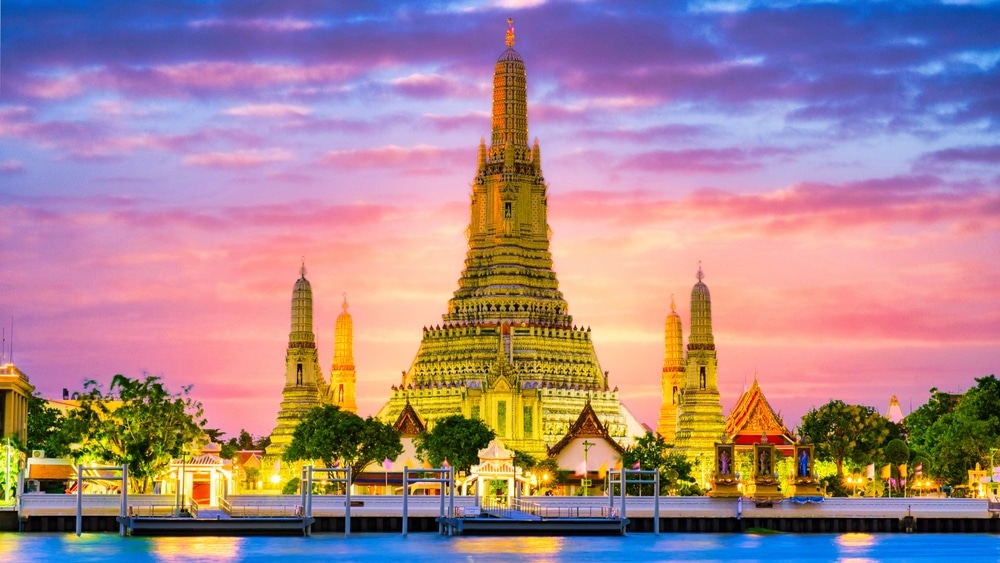Wat Arun, also known as the Temple of Dawn, is one of Bangkok’s most stunning landmarks, rich in history and architectural beauty. Situated on the western bank of the Chao Phraya River, this Buddhist temple is a marvel of intricate design and vibrant colors, making it a must-visit for travelers exploring Thailand’s capital.
The temple’s origins trace back to the Ayutthaya period, with significant restoration and expansion occurring during the reign of King Rama II in the early 19th century. Unlike traditional ancient ruins, Wat Arun stands as a beautifully preserved structure that continues to function as a place of worship and a symbol of Thai heritage.
Wat Arun is best known for its central prang (tower), which rises impressively to about 70 meters (230 feet) high. This prang is decorated with tiny pieces of colorful porcelain and seashells, meticulously arranged to create elaborate patterns and designs that glisten in the sunlight. Climbing the steep steps of the prang offers visitors breathtaking panoramic views of the river and the city beyond.
The temple complex also includes several other notable structures, such as smaller prangs, beautifully crafted pavilions, and statues of guardian demons, which are all part of the ornate landscape that reflects both Buddhist symbolism and Thai artistry.
More Information about Wat Arun (Temple of Dawn)
Basic Information:
- GPS Coordinates: 13.7437° N, 100.4880° E
- Address: 34 Arun Amarin Road, Wat Arun, Bangkok Yai, Bangkok 10600, Thailand
- Opening Hours: Daily, from 8:30 AM to 5:30 PM
- Entry Fee: Approximately 100 Thai Baht (prices may vary for international tourists)
- Best Time to Visit: Early morning or late afternoon for cooler temperatures and picturesque lighting; dawn or dusk offers a spectacular view of the temple illuminated.
Visitor Facilities and Accessibility:
- Facilities: Restrooms, souvenir shops, and refreshment stands are available on site. Modest dress is required; shoulders and knees should be covered, with sarongs available for rent or purchase at the entrance.
- Accessibility: Accessible by boat via Tha Tien Pier, which provides a scenic crossing over the Chao Phraya River. Limited parking is available for visitors arriving by car. The steep steps of the central prang may pose challenges for those with mobility issues.
- Family-Friendly: Suitable for families, but supervision is recommended when climbing the steep steps of the prang.
- Pet Policy: Not typically pet-friendly, as it is a religious site (N/A for most pets).
- Photography Tips: Ideal times for photography are early morning and sunset. The central prang’s porcelain details are best captured in natural light, and the view from across the river offers a classic shot of the temple’s silhouette against the sky.
Architectural and Cultural Significance:
- Architectural Style: Thai Buddhist architecture featuring a central prang adorned with colorful porcelain and seashell mosaics, surrounded by smaller prangs and statues of mythical guardians.
- Year Established: Dates back to the Ayutthaya period, with major restorations in the early 19th century during King Rama II’s reign.
- Historical Significance: While not an ancient ruin, Wat Arun is a historically significant temple with roots in the Ayutthaya period, reflecting the cultural and artistic evolution of Bangkok through centuries.
- Cultural Significance: An active place of worship and a symbol of Thai Buddhist culture, it hosts various religious ceremonies and remains a key part of the city’s spiritual landscape.
- Artworks/Decorations: Notable for its unique porcelain mosaics, intricate carvings, and statues of demons and other mythical creatures that guard the temple grounds.
Events and Activities:
- Special Events: Wat Arun hosts Buddhist ceremonies, including major festivals like Visakha Bucha Day and Loy Krathong, where the temple becomes a hub of local cultural activities.
- Guided Tours: Available on site or through external tour providers, often including multilingual guides who can provide insights into the temple’s history and significance.
- Workshops/Classes: N/A
- Interactive Exhibits: N/A
Dining and Shopping:
- On-Site Dining: Refreshment stands are available for snacks and drinks; nearby riverside cafes and restaurants offer a variety of Thai dishes with views of the temple.
- Shopping: Small souvenir shops within the temple grounds sell keepsakes like postcards, traditional crafts, and religious items.
Safety and Etiquette:
- Safety Tips: Be mindful of steep steps on the central prang and keep hydrated, especially in the heat. Watch for uneven surfaces and observe all safety barriers.
- Etiquette: Dress modestly as a sign of respect; avoid loud noises and be mindful of ongoing religious practices. Photography inside certain areas may be restricted.
- Emergency Contacts: Local security personnel are present, and first aid is available on site. For emergencies, the nearest hospital is Siriraj Hospital, located nearby across the river.
Miscellaneous:
- Website: Official websites and dedicated pages can provide updated visitor information, though they may vary.
- Contact Information: Not directly available; typically managed by the Thai Fine Arts Department or local tourism boards for inquiries.
- Social Media: N/A
Wat Arun is a vibrant blend of history, spirituality, and architectural beauty, making it not just a must-see in Bangkok but a captivating experience that offers a deeper connection to Thailand’s rich cultural tapestry. Whether you’re there to climb the prang, enjoy a serene moment by the river, or simply marvel at the detailed artistry, the Temple of Dawn promises a memorable visit.
#IconicLandmark, #ThaiBuddhistTemple, #StunningArchitecture, #RiversideViews, #CulturalHeritage

